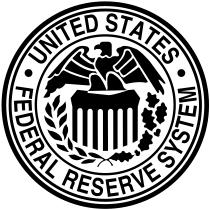Beige Book
The Beige Book, more formally called the Summary of Commentary on Current Economic Conditions, is a report published by the United States Federal Reserve Board eight times a year. The report is published in advance of meetings of the Federal Open Market Committee.[1] Each report is a gathering of "anecdotal information on current economic conditions" by each Federal Reserve Bank in its district from "Bank and Branch directors and interviews with key business contacts, economists, market experts, and others."
It is called the Beige Book because its cover is colored beige.
History
The Beige Book (at that time called the Red Book) would first be collected under the direction of Arthur Burns in 1970, seeking to formalize the process of collecting qualitative understandings of the various districts under the Federal Reserve.[2]
The Red Book would become public following the request of U.S. House of Representatives delegate Walter E. Fauntroy in 1983.[2] This public release would lead to the document being published with a Tan cover - later to be identified as Beige and named as such. Further care was taken to ensure that the document was anonymous with regards to the sources of the qualitative opinions within the text.[2]
While there was initial concern about the book becoming the subject of overinterpretation, the document itself was not much noticed until after the stock market crash of 1987, where it would become more frequently mentioned within financial and news publications like the Wall Street Journal, New York Times, and Washington Post.[2]
Consistent mention of the Beige Book has been made in public financial publications in years since, identifying it as both predictive and market influencing in nature - something which has since been followed up with scholarly consideration of these issues.
Beginning in 2017 the form and structure of the Beige Book has been changed to encourage more uniformity and comparability between individual districts reports.[3]
Beige Book Scholarship
While it was never the intention with the initial publication of the Beige Book that it would be predictive, various scholars have looked into its predictive or market influencing forces.[2][4][5][6] This is further complicated by the fact that the language within individual districts varies in nature with how it identifies the current market, outside of the subjective evaluations identified.[7] Other topics of research involve evaluating how effectively the Beige Book mirrors actual shifts in the financial climate of a given district.[8] Current thoughts are that while the beige book may forecast to a small degree, its forecasts are largely influenced by various other factors like the irregular release schedule of the text and the more widely varying economic nature of each individual district.[7]
References
- Melinda Peer (January 12, 2011). "Beige Book Notes Small Steps". TheStreet. New York. Retrieved March 24, 2016.
- Rolnick, Arthur; Runkle, David (March 1, 1999). Fettig, David (ed.). "The Federal Reserve's Beige Book: A Better Mirror than Crystal Ball". The Region.
- "The Fed - Frequently Asked Questions". Board of Governors of the Federal Reserve System. Retrieved 2018-03-16.
- Balke, Nathan; Yücel, Mine (2000). "Evaluating the Eleventh District's Beige Book" (PDF). Economic and Financial Review. Fourth Quarter 2000: 1–10.
- Zavodny, Madeline; Ginther, Donna K. (2005). "Does the Beige Book Move Financial Markets?". Southern Economic Journal. 72 (1): 138–151. CiteSeerX 10.1.1.527.485. doi:10.2307/20062098. JSTOR 20062098.
- Balke, Nathan S.; Fulmer, Michael; Zhang, Ren (2017-08-01). "Incorporating the Beige Book into a Quantitative Index of Economic Activity". Journal of Forecasting. 36 (5): 497–514. doi:10.1002/for.2450. ISSN 1099-131X.
- Armesto, Michelle T.; Hernández-Murillo, Rubén; Owyang, Michael T.; Piger, Jeremy (2009-02-01). "Measuring the Information Content of the Beige Book: A Mixed Data Sampling Approach". Journal of Money, Credit and Banking. 41 (1): 35–55. doi:10.1111/j.1538-4616.2008.00186.x. ISSN 1538-4616.
- Brave, Scott; Walstrum, Thomas; Berman, Jacob (2015). "The Chicago Fed Survey of Business Conditions: Quantifying the Seventh District's Beige Book Report". Economic Perspectives. 39 (3): 77–89. ISSN 0164-0682.
